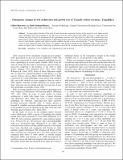Mostrar el registro sencillo del ítem
Ontogenetic changes in web architecture and growth rate of Tengella radiata(Araneae, Tengellidae)
| dc.creator | Madrigal Brenes, Ruth | |
| dc.creator | Barrantes Montero, Gilbert | |
| dc.date.accessioned | 2019-09-10T21:54:49Z | |
| dc.date.available | 2019-09-10T21:54:49Z | |
| dc.date.issued | 2008 | |
| dc.identifier.issn | 0160-8202 | |
| dc.identifier.uri | https://hdl.handle.net/10669/79083 | |
| dc.description.abstract | In some spiders features of the webs of early instars may represent features of the ancestor's web. Some second instar spiderlings (first instar outside of the egg sac) of Tengella radiata (Kulczynski 1909) construct a small sheet web without any type of retreat. In subsequent instars, spiderlings construct webs that consist of a sheet with a small retreat that opens near its center. Webs gradually change as spiderlings growth and webs of 7th instar spiders are indistinguishable from those of adult females. Spiders only begin to include cribellate threads in their webs during the 7th instar. The growth of T. radiata is slow during the first three instars, but spiders' sizes increase steadily in the subsequent stages. Legs I of adult males are longer than in females, indicating an allometric growth that occurred mainly during the last molt of males. | en |
| dc.language.iso | en | |
| dc.source | Journal of Arachnology 36(3):545-551 | |
| dc.subject | Spiderlings’ webs | en |
| dc.subject | cribellate silk | en |
| dc.subject | cephalothorax | en |
| dc.subject | leg growth | en |
| dc.title | Ontogenetic changes in web architecture and growth rate of Tengella radiata(Araneae, Tengellidae) | en |
| dc.type | artículo original | |
| dc.identifier.doi | 10.1636/ST07-66.1 | |
| dc.description.procedence | UCR::Vicerrectoría de Docencia::Ciencias Básicas::Facultad de Ciencias::Escuela de Biología |
Ficheros en el ítem
Este ítem aparece en la(s) siguiente(s) colección(ones)
-
Biología [1652]


